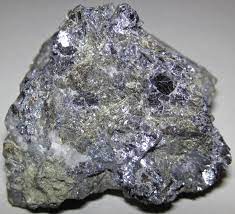
The Earth's rich geological diversity has blessed us with a wide array of mineral resources, each with its unique characteristics and potential applications. Among these valuable minerals, lead-zinc ore holds a prominent position.
Lead-zinc ore is a mineral deposit that primarily consists of lead and zinc minerals, often found in combination with other elements such as sulfur, iron, and silver. It is commonly extracted from the Earth's crust through mining operations. These ores are vital sources of lead and zinc, which are essential metals in various industrial sectors.
The formation of lead-zinc ore involves complex geological processes occurring over millions of years. It typically occurs in hydrothermal deposits, where hot, mineral-rich fluids permeate through fractures in the Earth's crust. These fluids, enriched with lead and zinc ions, interact with surrounding rocks, resulting in the deposition of ore minerals.
Properties of Lead-Zinc Ore
Lead-zinc ore exhibits distinct properties that make it valuable for industrial use:
Mineral Composition: Lead-zinc ores contain several mineral species, including galena (lead sulfide, PbS), sphalerite (zinc sulfide, ZnS), and other accompanying minerals such as pyrite (iron sulfide, FeS₂). The ratio of lead to zinc content in the ore varies, influencing its economic value and applications.
Ore Grades: The concentration of lead and zinc in the ore is measured by its grade. Higher-grade ores are economically more viable due to the larger amounts of these metals they contain.
Physical Properties: Lead-zinc ore often appears as dense, bluish-gray rock formations with a metallic luster. Its hardness varies depending on the mineral composition, ranging from 2.5 to 4 on the Mohs scale.
Nigeria, located in West Africa, is blessed with a rich abundance of mineral resources. Among its significant deposits are lead-zinc ore, which plays a crucial role in various industries globally. This article explores the location of lead-zinc ore deposits in Nigeria, their geological characteristics, and their numerous applications across different sectors.
Geological Overview
Lead and zinc are naturally occurring elements found in the Earth's crust. They are often found together in ore deposits due to their similar chemical properties. Lead-zinc ore deposits in Nigeria are primarily associated with sedimentary rocks of the Benue Trough. This geological formation stretches across several states in Nigeria, including Ebonyi, Benue, Nasarawa, Plateau, and Taraba.
Location of Lead-Zinc Ore Deposits in Nigeria
Ebonyi State: Ebonyi State, situated in southeastern Nigeria, is renowned for its vast lead-zinc deposits. The major mining areas in Ebonyi State include Ishiagu, Ameri, Ameka, Uburu, and Enyigba.
Benue State: Benue State, located in central Nigeria, is another significant hub for lead-zinc ore deposits. Key mining sites in Benue State include Gboko, Ado, and Makurdi.
Nasarawa State: Nasarawa State, adjacent to Benue State, also hosts substantial lead-zinc reserves. The mining areas of interest in Nasarawa State are Wamba, Akwanga, and Udege-Mbeki.
Plateau State: Plateau State, often referred to as the "Home of Tin Mining," is famous for its extensive mineral resources. It is one of the leading producers of lead-zinc ores in Nigeria. Notable mining sites in Plateau State include Jos, Bukuru, Ropp, and Zurak.
Taraba State: Taraba State, located in northeastern Nigeria, is known for its diverse mineral wealth. Lead-zinc ore deposits can be found in areas such as Mayo Lope, Mayo Kebbi, and Wukari.
Geological Characteristics of Lead-Zinc Ore Deposits
Lead-zinc ore deposits in Nigeria are predominantly stratiform in nature, occurring in layers or bands within sedimentary rocks. These deposits are often associated with dolomite, limestone, shale, and sandstone formations. The ore bodies are typically hosted in fractured or faulted zones, which facilitate the accumulation of lead and zinc minerals.
Mineralization Process
The formation of lead-zinc ore deposits in Nigeria is attributed to hydrothermal processes. These involve the circulation of hot fluids through the rocks, carrying dissolved metals. When the fluids encounter suitable host rocks, they precipitate and deposit lead and zinc minerals, resulting in ore formation. The mineralization is usually accompanied by other valuable metals like copper, silver, and gold.
Industrial Uses of Lead-Zinc Ores
Lead and zinc are essential metals used in various industries due to their distinct properties. Some of their primary applications include:
Battery Production: Lead is a critical component in the manufacturing of lead-acid batteries, which are widely used in automobiles, uninterruptible power supply (UPS) systems, and renewable energy storage.
Construction and Galvanization: Zinc is commonly used as a corrosion-resistant coating for iron and steel, a process known as galvanization. It protects structures, such as buildings, bridges, and pipelines, from rust and extends their lifespan.
Alloy Production: Both lead and zinc are utilized in the production of alloys. Lead-based alloys find applications in soldering, ammunition, and radiation shielding. Zinc alloys, such as brass (zinc and copper) and zinc-aluminum alloys (ZA alloys), are used in die-casting, automotive parts, and architectural fittings.
Chemical Industry: Zinc compounds are employed in the production of various chemicals, including fertilizers, pigments, rubber additives, and pharmaceuticals. Lead compounds have applications in the manufacture of ceramics, glass, and paints.
Electronics and Electrical Appliances: Lead is still utilized in certain electronic components, such as soldering materials, due to its excellent electrical conductivity and malleability.
Environmental Concerns and Regulations
The extraction and processing of lead-zinc ores can have environmental implications if not properly managed. The release of heavy metals into the air, soil, and water can lead to pollution and pose health risks to both humans and ecosystems. To mitigate these concerns, regulatory measures are in place to enforce responsible mining practices, waste management, and emission control.
In conclusion, Nigeria possesses significant lead-zinc ore deposits, primarily located in states such as Ebonyi, Benue, Nasarawa, Plateau, and Taraba. These deposits are formed through hydrothermal processes and occur within sedimentary rocks.
The lead and zinc ores extracted from these deposits find extensive applications in batteries, construction, alloys, chemicals, electronics, and various other industries. As Nigeria continues to harness its mineral resources sustainably, it must prioritize environmental stewardship and adhere to stringent regulations to minimize the impact on the ecosystem and human health.























